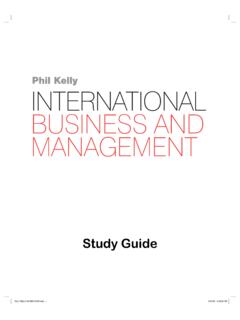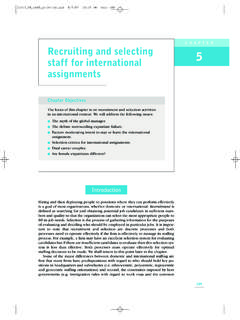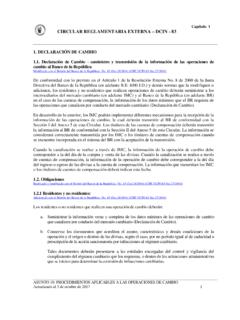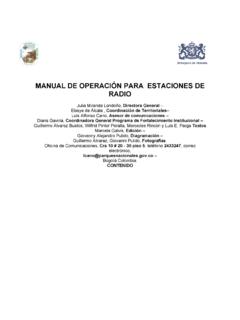Transcription of OPERATIONS, STRATEGY AND OPERATIONS …
1 21 CHAPTER 2 OPERATIONS , STRATEGY ANDOPERATIONS STRATEGYINTRODUCTIONAn organization s OPERATIONS function is concerned with getting thingsdone; producing goods and/or services for customers. Chapter 1pointed out that OPERATIONS management is important because it isresponsible for managing most of the organization s resources. How-ever, many people think that OPERATIONS management is only con-cerned with short-term, day-to-day, tactical issues. This chapter willseek to correct that view by considering the strategic importance business organizations are concerned with how they will surviveand prosper in the future. A business STRATEGY is often thought of as aplan or set of intentions that will set the long-term direction of theactions that are needed to ensure future organizational success. How-ever, no matter how grand the plan, or how noble the intention, anorganization s STRATEGY can only become a meaningful reality, in prac-tice, if it is operationally enacted.
2 An organization s OPERATIONS arestrategically important precisely because most organizational activitycomprises the day-to-day activities within the OPERATIONS function. It isthe myriad of daily actions of OPERATIONS , when considered in theirtotality that constitute the organization s long-term strategic relationship between an organization s STRATEGY and its operationsis a key determinant of its ability to achieve long-term success or evensurvival. Organizational success is only likely to result if short-term op-erations activities are consistent with long-term strategic intentions andmake a contribution to competitive advantage. The relationship between OPERATIONS and the other business func-tions is similarly important. The objective of the OPERATIONS function isto produce the goods and services required by customers whilst man-aging resources as efficiently as possible.
3 This can lead to conflictswithin an organization. Conflicts between the OPERATIONS and theLEARNING OBJECTIVESOn completion of this chapter, you should be able to:Understand the relationship between OPERATIONS the roles that OPERATIONS can play withinorganizational the strategic significance of operationsmanagement to organizations of all the key strategic decision areas of operationsmanagement that constitute an OPERATIONS 9/25/07 10:01 AM Page 21marketing functions are likely to centre on the desire of marketing to ensure that operationsconcentrate on satisfying customers. Whilst this may seem desirable, marketing will usuallywant OPERATIONS to be able to meet customer needs under any circumstances. This is likelyto lead to demands to produce greater volumes, more variety, higher quality, a fasterresponse, and so on, all of which are likely to lead to less efficient OPERATIONS .
4 Conflicts be-tween the OPERATIONS and the accounting and finance functions, on the other hand, are likelyto centre on the desire of accounting and finance to want OPERATIONS to manage resourcesas efficiently as possible. This will tend to pull OPERATIONS in exactly the opposite directionof that desired by marketing. Conflicts between OPERATIONS and the human resource man-agement function are likely to centre on issues of recruitment, selection, training, manage-ment and the reward of those employed within OPERATIONS . For example, operationsmanagers may want to vary organization-wide policies in order to meet local needs; a movelikely to be resisted by human resource managers. The OPERATIONS function lies at the heartof any organization and interacts with all the other functions. As such, achieving agreementabout what decision areas lie within the remit of OPERATIONS , and what should be the basisof decision-making within OPERATIONS is an essential part of ensuring the consistency ofaction over time necessary for a successful organizational NATURE OF STRATEGYS trategy is one of the most over-used words in the business dictionary.
5 Yet, surprisingly,there is no agreement on what the term actually means. No-one challenges its militaryorigin, used with regard to how a commander might deploy his resources ( armedforces) throughout a campaign aimed at achieving a particular objective ( con-quering territory or thwarting an invasion). The idea that a business organizationcould have a STRATEGY seems to have first emerged in the 1960s, when the techniquesof long-term business planning were first popularized. Since then many different in-terpretations of the concept and practice of strategic management have been devel-oped. Indeed, entire books have been given over to contemplating the nature ofstrategy. For example, Mintzberg et al.(1998) characterize ten schools of thought intheir consideration of what constitutes STRATEGY . A widely accepted definition isoffered by Johnson et al.
6 (2005), who define strategyas the direction and scope of anorganization over the long-term, which achieves advantage in a changing environ-ment through its configuration of resources with the aim of fulfilling stakeholderexpectations . In its determination of the long-term direction of an organization, strat-egy involves the interplay of three elements: the organization s external environment,its resources and its objectives (in meeting the expectations of its stakeholders). OPERATIONS management is principally concerned with the organizational , the way that the OPERATIONS function manages resources will impact both theway that the organization interacts with its external environment and its ability tomeet the needs of its stakeholders. Thus, OPERATIONS management is an integral partof an organization s can be considered to exist at three levels in an organization (see Table ): Corporate level STRATEGY : Corporate level STRATEGY is the highest level ofstrategy.
7 It sets the long-term direction and scope for the whole the organization comprises more than one business unit, corporate levelstrategy will be concerned with what those businesses should be, howresources ( cash) will be allocated between them, and how relationshipsbetween the various business units and between the corporate centre and thebusiness units should be managed. Organizations often express their strategyin the form of a corporate mission or vision statement. PART ONEINTRODUCTION TO OPERATIONS MANAGEMENT22strategyThe direction and scope of anorganization over the long-term, whichachieves advantage in a changingenvironment through its configurationof resources with the aim of fulfillingstakeholder expectations (Johnson et al.,2005). 9/25/07 10:01 AM Page 22 Business level STRATEGY : Business level STRATEGY is primarily concerned with howa particular business unit should compete within its industry, and what itsstrategic aims and objectives should be.
8 Depending upon the organization scorporate STRATEGY and the relationship between the corporate centre and itsbusiness units, a business unit s STRATEGY may be constrained by a lack ofresources or strategic limitations placed upon it by the centre. In singlebusiness organizations, business level STRATEGY is synonymous with corporatelevel STRATEGY . Functional level STRATEGY : The bottom level of STRATEGY is that of the individualfunction ( OPERATIONS , marketing, finance, etc.) These strategies are concernedwith how each function contributes to the business STRATEGY , what theirstrategic objectives should be and how they should manage their resources inpursuit of those objectives. The remainder of this chapter will consider in more detail what constitutes an op-erations STRATEGY and what its relationship is with the other constituents of organiza-tional STRATEGY .
9 As Hayes et al.(2005) point out, effective OPERATIONS strategies needto be consistent and contribute to competitive advantage (see Table ). Details of the constituents of an OPERATIONS STRATEGY are explored in more detail inChapters 5 through 14. CHAPTER 2 OPERATIONS , STRATEGY AND OPERATIONS STRATEGY23 STRATEGYKEY LEVELISSUESC orporate What businesses shall we be in? What businesses shall we acquire or divest? How do we allocate resources between businesses? What is the relationship between businesses? What is the relationship between the centre and the businesses?Business How do we compete in this business? What is the mission of this business? What are the strategic objectives of this business?Function How does the function contribute to the business STRATEGY ? What are the strategic objectives of the function?
10 How are resources managed in the function? What technology do we use in the function? What skills are required by workers in the function?TABLE of strategyConsistency(Is the )Contribution tocompetitiveadvantage(Does ) Between the OPERATIONS STRATEGY and business STRATEGY Between OPERATIONS STRATEGY and the other functionalstrategies Between the different decision areas of OPERATIONS STRATEGY Enable OPERATIONS to set priorities that enhance competitiveadvantage Highlight opportunities for OPERATIONS to complement thebusiness STRATEGY Make OPERATIONS STRATEGY clear to the rest of the organization Provide the operating capabilities that will be required in thefutureTABLE forevaluating an OPERATIONS STRATEGY (ADAPTED FROM HAYES ET AL.,2005 P. 71) 10/3/07 1:03 PM Page 23 OPERATIONS AND STRATEGYS trategy in a business organization is essentially about how the organization seeks tosurvive and prosper within its environment over the long-term.
















